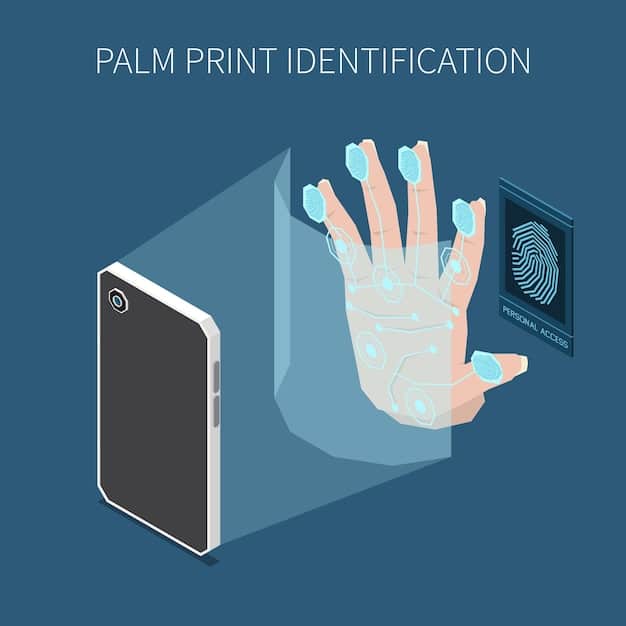Contactless Payments in US E-commerce: Trends & Opportunities for 2025

The Future of Contactless Payments in US E-commerce: Trends and Opportunities for 2025 will likely see increased adoption of mobile wallets, biometric authentication, and blockchain technologies, driven by enhanced security, convenience, and evolving consumer preferences for seamless and secure online transactions.
The world of e-commerce is constantly evolving, and the way we pay for goods and services online is no exception. As we look ahead to 2025, it’s clear that the future of contactless payments in US e-commerce: trends and opportunities for 2025 is poised for significant growth and innovation. Let’s explore the key trends shaping this exciting landscape and uncover the opportunities that lie ahead for businesses and consumers alike.
Understanding the Current State of Contactless Payments
Contactless payments have steadily gained traction in the US e-commerce market over the past few years. Driven by factors such as increased security, convenience, and speed, consumers are increasingly opting for digital payment methods that eliminate the need for physical cards.
Several factors contribute to the growing popularity of contactless payments. The COVID-19 pandemic accelerated the adoption of contactless options as consumers sought safer ways to transact. Furthermore, advancements in technology, such as mobile wallets and NFC-enabled devices, have made contactless payments more accessible and user-friendly.
Key Drivers of Contactless Payment Adoption
The rise of contactless payments is fueled by several key factors. Convenience is a major driver, as contactless payments offer a faster and more streamlined checkout experience compared to traditional methods. Additionally, security concerns have prompted consumers to embrace contactless options, which often incorporate advanced encryption and fraud prevention measures.
- Enhanced Security: Contactless payments utilize tokenization and encryption to protect sensitive card information, reducing the risk of fraud.
- Increased Convenience: Contactless payments are faster and more convenient than traditional card swipes or chip inserts, streamlining the checkout process.
- Growing Consumer Awareness: Consumers are becoming more aware of the benefits of contactless payments, driving increased adoption.
- Retailer Adoption: More and more retailers are accepting contactless payments, making them a more viable option for consumers.
The increasing prevalence of mobile wallets, such as Apple Pay, Google Pay, and Samsung Pay, has also played a significant role in the growth of contactless payments. These digital wallets allow users to store their payment information securely on their smartphones and make purchases with a simple tap or scan.
In conclusion, the current state of contactless payments in US e-commerce is characterized by steady growth, driven by convenience, security, and technological advancements. As we look ahead, these trends are expected to continue shaping the future of online transactions.
Emerging Trends in Contactless Payments for 2025
Looking ahead to 2025, several emerging trends are poised to transform the landscape of contactless payments in US e-commerce. These trends include the rise of biometric authentication, the integration of blockchain technology, and the increasing adoption of alternative payment methods.
One of the most significant trends is the growing use of biometric authentication for online payments. Biometrics, such as fingerprint scanning and facial recognition, offer a more secure and convenient way to verify transactions. This technology can help to reduce fraud and improve the overall user experience.

Biometric Authentication
Biometric authentication is rapidly gaining traction in the e-commerce space. Fingerprint scanning, facial recognition, and even voice recognition are being used to verify transactions, adding an extra layer of security and convenience for consumers.
The use of biometrics can help to reduce fraud and improve the overall security of online payments. By verifying the identity of the user through unique biological traits, it becomes much harder for fraudsters to gain access to sensitive payment information.
- Fingerprint Scanning: Many smartphones and laptops now come equipped with fingerprint scanners, making it easy for users to authenticate payments with a simple touch.
- Facial Recognition: Facial recognition technology is becoming increasingly sophisticated, allowing users to verify their identity by simply looking at their device.
- Voice Recognition: Voice recognition is another emerging biometric authentication method that can be used to verify transactions through voice commands.
Another key trend is the integration of blockchain technology into contactless payment systems. Blockchain offers a secure and transparent way to record and verify transactions, reducing the risk of fraud and improving the efficiency of payment processing. This technology could revolutionize the way we pay for goods and services online.
In summary, emerging trends in contactless payments for 2025 include the rise of biometric authentication and the integration of blockchain technology, both of which promise to enhance the security and convenience of online transactions.
The Impact of Mobile Wallets on E-commerce
Mobile wallets have become increasingly popular in recent years, and their impact on US e-commerce is undeniable. These digital wallets allow users to store their payment information securely on their smartphones and make purchases with a simple tap or scan.
The convenience and security offered by mobile wallets have made them a favorite among consumers. With mobile wallets, users no longer need to carry physical cards or enter their payment information manually for each transaction. This streamlined checkout process can lead to higher conversion rates for e-commerce businesses.
Benefits of Mobile Wallets for Consumers
Mobile wallets offer numerous benefits for consumers. They provide a convenient and secure way to store payment information, simplify the checkout process, and offer rewards and loyalty programs.
One of the key advantages of mobile wallets is their enhanced security. Mobile wallets use tokenization and encryption to protect sensitive card information, reducing the risk of fraud. Additionally, many mobile wallets require biometric authentication, such as fingerprint scanning or facial recognition, to verify transactions.
- Convenience: Mobile wallets allow users to make payments with a simple tap or scan, eliminating the need to carry physical cards.
- Security: Mobile wallets use tokenization and encryption to protect sensitive card information, reducing the risk of fraud.
- Rewards and Loyalty Programs: Many mobile wallets offer rewards and loyalty programs, allowing users to earn points or cashback on their purchases.
For e-commerce businesses, accepting mobile wallet payments can lead to higher conversion rates and increased customer satisfaction. By offering a seamless and secure checkout experience, businesses can encourage more customers to complete their purchases.
In conclusion, mobile wallets have had a significant impact on US e-commerce, offering convenience, security, and rewards for consumers, and driving higher conversion rates for businesses.
Security Considerations and Fraud Prevention
As contactless payments become more prevalent in US e-commerce, security considerations and fraud prevention are of paramount importance. Protecting sensitive payment information and preventing fraudulent transactions are essential for maintaining consumer trust and ensuring the integrity of the payment system.
One of the key strategies for enhancing security is the use of tokenization. Tokenization involves replacing sensitive card information with a unique token, which is used to process the payment. This token is useless to fraudsters, as it cannot be used to make unauthorized purchases.
Strategies for Enhancing Security
Several strategies can be employed to enhance the security of contactless payments. These include tokenization, encryption, biometric authentication, and fraud detection systems.
In addition to tokenization, encryption plays a crucial role in protecting payment data. Encryption involves scrambling the data so that it is unreadable to unauthorized parties. This helps to prevent fraudsters from intercepting and stealing sensitive payment information.
- Tokenization: Replacing sensitive card information with a unique token.
- Encryption: Scrambling payment data to prevent unauthorized access.
- Biometric Authentication: Using fingerprint scanning, facial recognition, or voice recognition to verify transactions.
Fraud detection systems are also essential for preventing fraudulent transactions. These systems use advanced algorithms and machine learning to identify suspicious activity and flag potentially fraudulent transactions for review.

By implementing these security measures, e-commerce businesses can reduce the risk of fraud and protect their customers’ payment information. This can help to build trust and confidence in the contactless payment system.
In summary, security considerations and fraud prevention are critical aspects of the future of contactless payments in US e-commerce. Strategies such as tokenization, encryption, and fraud detection systems are essential for protecting payment data and preventing fraudulent transactions.
Opportunities for Businesses in the Contactless Payment Landscape
The rise of contactless payments in US e-commerce presents numerous opportunities for businesses to enhance their operations, improve customer experience, and drive growth. By embracing contactless payment technology, businesses can gain a competitive edge and attract more customers.
One of the key opportunities is the ability to offer a more seamless and convenient checkout experience. Contactless payments are faster and easier than traditional payment methods, which can lead to higher conversion rates and increased customer satisfaction.
Leveraging Contactless Payments for Growth
Businesses can leverage contactless payments to drive growth by offering a more convenient checkout experience, increasing customer loyalty, and reducing fraud.
Another opportunity is the ability to increase customer loyalty through rewards and loyalty programs. Many mobile wallets and contactless payment systems offer rewards and loyalty programs, allowing businesses to incentivize customers to use these payment methods.
- Improved Customer Experience: Offering a faster and more convenient checkout experience.
- Increased Customer Loyalty: Incentivizing customers to use contactless payments through rewards and loyalty programs.
- Reduced Fraud: Implementing security measures such as tokenization and encryption reduces the risk of fraud.
Businesses can also benefit from reduced fraud by implementing security measures such as tokenization and encryption. These measures can help to protect sensitive payment information and prevent fraudulent transactions, saving businesses time and money.
In conclusion, the contactless payment landscape offers numerous opportunities for businesses to enhance their operations, improve customer experience, and drive growth. By embracing contactless payment technology, businesses can gain a competitive edge and attract more customers.
Challenges and Obstacles to Widespread Adoption
While the future of contactless payments in US e-commerce looks promising, there are still several challenges and obstacles to widespread adoption. Overcoming these challenges will be crucial for realizing the full potential of contactless payments.
One of the main challenges is the lack of consumer awareness and education. Many consumers are still unfamiliar with contactless payments and may not understand the benefits they offer. Businesses need to educate consumers about the convenience, security, and rewards associated with contactless payments.
Addressing Key Challenges
Several key challenges need to be addressed to achieve widespread adoption of contactless payments. These include consumer awareness, infrastructure limitations, and security concerns.
Another challenge is the need for infrastructure upgrades. Not all e-commerce platforms and payment terminals are equipped to accept contactless payments. Businesses need to invest in upgrading their infrastructure to support these payment methods.
- Consumer Awareness: Educating consumers about the benefits of contactless payments.
- Infrastructure Limitations: Upgrading e-commerce platforms and payment terminals to support contactless payments.
- Security Concerns: Addressing concerns about the security of contactless payments through tokenization, encryption, and fraud detection systems.
Security concerns also remain a barrier to widespread adoption. Some consumers are hesitant to use contactless payments because they worry about the security of their payment information. Businesses need to address these concerns by implementing robust security measures and communicating them effectively to consumers.
In summary, several challenges and obstacles need to be addressed to achieve widespread adoption of contactless payments in US e-commerce. These include consumer awareness, infrastructure limitations, and security concerns.
| Key Point | Brief Description |
|---|---|
| 🚀 Mobile Wallet Growth | Increasing use of Apple Pay, Google Pay, and Samsung Pay in e-commerce. |
| 🔒 Biometric Security | Fingerprint and facial recognition enhance payment security. |
| 🛡️ Fraud Prevention | Tokenization and encryption protect against fraudulent transactions. |
| 💰 Business Opportunities | Improved customer experience and higher conversion rates for businesses. |
Frequently Asked Questions
▼
Contactless payments are transactions made without physical contact between a payment card and a terminal. They use technologies like NFC and mobile wallets for quick and secure payments.
▼
Contactless payments are very secure. They utilize tokenization and encryption, which protect card details. Biometric authentication adds another layer of security.
▼
Mobile wallets are expected to grow significantly. More consumers are using them due to their convenience and security, and retailers are increasingly accepting them too.
▼
Benefits for businesses include faster checkout times, increased customer satisfaction, and higher conversion rates. Contactless payments can also reduce fraud and operational costs.
▼
Challenges include upgrading infrastructure, educating consumers, and addressing security concerns. Overcoming these challenges is critical for widespread adoption and success.
Conclusion
As we look towards 2025, the future of contactless payments in US e-commerce: trends and opportunities for 2025 is undeniably bright. By embracing emerging trends, addressing key challenges, and prioritizing security, businesses can unlock the full potential of contactless payments and create a more convenient and secure online shopping experience for consumers.





